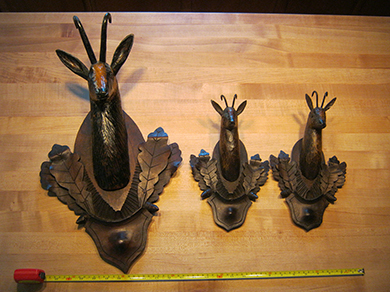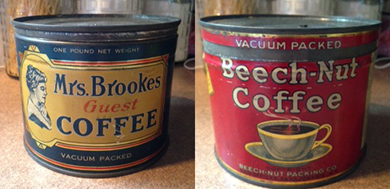 |
|
|||
 |
 |
|||
Copyright © Harry Rinker, LLC 2016 Questions
and Answers
QUESTION: I recently purchased a lot of two antique coffee cans for $60.00. The first is for Mrs. Brookes Grind Coffee. The second is for Beech-Nut Coffee. Both cans are in very good condition. When I returned home, I did some research. I was surprised to find a 2011 value of $385.00 for the Mrs. Brookes can on the Kovel website. Is this still a valid price in 2016? What is your take on my purchases? – LH, State College, PA, Email Question
ANSWER: Beech-Nut Packing Company, now Beech-Nut Corporation, was founded in 1891 and located in Canajohaire, New York. Beech-Nut is credited for patenting the first vacuum jar. Eventually, the technology was applied to vacuum packed cans. Beech-Nut produced a wide variety of packaged goods including baby food, chewing gum, fruit drops, peanut butter, and pork and beans. In 2009, a new factory, located 20 miles outside Canajohaire, opened. Preferring to date conservatively, your Beech-Nut coffee tin is from the late 1940s or 1950s. The coffee-cup image on your Beech-Nut can is uncommon. Most cans have an oval Beech-Nut Roasted Coffee logo beneath the wording. These common tins sell in the $10.00 to $15.00 range. WorthPoint.com lists an example of your coffee-cup image can that sold on eBay on March 28, 2016 for $41.00. A similar example sold on eBay on April 18, 2012 for $35.00. Although the imagery on your Mrs. Brookes Guest Coffee tin suggests an earlier origin, I date it from the same period – late 1940s or 1950s. Mrs. Brookes remains a mystery. With the exception of the 2011 listing in the Kovels’ price guide, I found no other information about the brand or manufacturer. I am reluctant to accept single price information. The circumstances that led a dealer to ask that price or two competitors to bid the can up to that price are unknown. Further, finding a buyer willing to pay anywhere near the $385.00 price will require a great deal of effort. When analyzing the value of items purchased as a lot, your two coffee tins demonstrate that splitting the cost and assigning an equal value to both objects makes no sense. Clearly, the Mrs. Brookes Guest Coffee tin is worth more than the Beech-Nut Coffee tin. Fred Dodge’s “Antique Tins Identification & Values” Book 1 and Book 2 (1998), published by Collector Books, are the primary identification research sources for advertising tins. They were published at the height of the coffee, tobacco, and tin packaging collecting craze. Eighteen years have passed without an update, a clear indication the secondary market has fallen on hard times, especially for common and harder-to-find examples. There are advanced collectors, antiques in their own right, who spend top dollar to acquire upper echelon and masterpiece units. With the generation who remembers buying coffee in tins dying, long-term financial prospects are questionable. Since you collect coffee tins, you did well. Sixty dollars for the two is a bargain. Be as astute with your buying dollars in the future. QUESTION: In the late 1940s, my father bought seven Mettlach steins, one holding three liters and six holding one liter, from a local antiques dealer. The large three-liter stein stands 17 1/2 inches high and has a base diameter of 8 inches. It is marked on the bottom “2194.” The lid features a relief turtle. The body contains a top and bottom band with a poem. One verse reads: “IM SCHWARZEN WALFISH ZU ASCALON, WIRD KEIN PROPHET GEEHRT, UND WER VERGNÜGT DORT LIEBEN WILL, ZAHLT BAAR, WAS ER VERZEHRT.” The main portion of the body contains a Wedgewood jasper-like panel featuring three mural scenes of elves and a drinking motif, each scene separated by columns. The handle is in the shape of an alligator. What is the value of my stein? – WH, Zelienople, PA, Letter ANSWER: Your Mettlach stein #2194 is known as The Black Whale at Ascalon stein among collectors. The verses are from a popular German universities beer drinking song entitled “Im schwarzen Walfish zu Askalon.” Although the melody is old, Joseph Victor von Schefell created the lyrics in 1854. The song celebrates the Bacchanalian life. When presented a bar bill after three days of drinking, a student of the classics claims to have left his money at home. The bartender throws the student and his friends out into the street. The students leave singing a song lamenting the fact that a prophet has no honor in his own country. The song has multiple verses, including political commentaries and mocking insults of Heidelberg fraternities. The story has lent its name to numerous German inns and restaurants including establishments in Heidelberg and Bad Säckingen. The basic story verses are found on your Mettlach stein. The translation for the verse you provided is: “In the Black Whale at Ascalon; No prophet hath renown; And he who there would drink in peace; Must pay the money down.” [See: https://en.wikipedia.org/wiki/Im_schwarzen_Walfisch_zu_Askalon] I found two sell through records for your Mettlach #2194 stein. Several websites including www.liveauctioneers.com reported Burchard Galleries, Inc., of Florida sold an example for $375.00. The bidding started at $250.00. WorthPoint.com lists an example that sold for $355.00 on eBay on June 18, 2010. I did find a sell through listing on eBay.ca, Canadian eBay, for $624.99. I was not able to determine the date of the sale. I also found a stein dealer who was asking $600.00 for an example with the lid missing. While tempted to accept the $624.99 as an indication of increased market interest, it is most likely an anomaly. Mettlach steins, especially in the American marketplace, were one of the many collecting categories impacted financially by the 2008-2009 Great Recession. In addition, the stein collector base is aging. Young collectors, even in Europe, are not replacing older collectors. Having lived through the Golden Age of Mettlach stein collecting (1980s and 1990s), it is sad to witness the financial decline. A realistic value for your stein is $400.00 to $450.00. A specialized stein dealer will ask more, but he/she has developed the clientele to pay it. QUESTION: Some years ago, I received three Austrian trophy chamois mounts from a friend. The base of each is a wooden oak leaf plaque with a shield drop. Mounted on each is a carved wooden head of a chamois with antlers attached to it. Normally such plaques have a portion of the skull with the antlers. The largest example measures 20 inches high by 13 inches wide. The two smaller examples measure 12” high by 7” wide. My guess is that they are 100 years old. The friend who gave them to me said they were valuable. I have my doubts. – JE, Churchtown, PA, Email Question. 
ANSWER: The chamois is a goat-antelope species native to the Apennines, Balkins, Carpartians, Caucasus, European Alps, Pyrenees, and Tatra Mountains. The animal has multiple names throughout the countries in which it is found. Chamois are small animals, ranging in height from 28 to 31 inches and 42 to 54 inches in length. They live in moderately high altitudes and prefer a precipitous, rugged, rocky terrain. They travel in herds of up to 100 animals. Chamois are primarily vegetarians. Although hunted for sport, chamois also are bred for their leather. When properly processed, the hide is smooth and absorbent. It is used for polishing because it produces no scratching. When visiting friends in Germany and elsewhere in Europe whose family history dates back into the nineteenth century, I often encountered mounted chamois plaques, many of which contain the date and location where the animal was shot. I doubt if the heirs care about them. The secondary market for these mounts is minimal, even in Europe. Smaller examples sell in the $35.00 to $40.00 range. Large examples approach $75.00. The carved heads of your chamois mounts make them conversation pieces, albeit I doubt if anyone is going to hang them in his/her living room. If you wish to sell them, sell them as a set. Take any offer over $100.00 for the three. QUESTION: Knowing that pre-1982 copper pennies have a higher copper content than later pennies, I have been accumulating a hoard of pre-1982 copper pennies. Is this a wise approach or am I wasting my time? I also understand that nickels made between 1942 and 1945 have silver content. Should I be acquiring these for melt? – Reading, PA ANSWER: New laws make it illegal to melt pennies and nickels. This aside, the price of copper has fallen. As of October 10, 2016, the melt value of a pre-1982 penny was $1.44 per hundred. Jefferson nickels from 1942 through 1945 did contain 35 percent silver. Again, it is illegal to melt them. In addition, the silver content of Kennedy half dollars issued between 1966-1970 contained only 40 percent silver, a factor dealers buying for melt take into consideration. Harry L. Rinker welcomes questions from readers about
collectibles, those mass-produced items from the twentieth and twenty-first centuries.
Selected letters will be answered in this column.
Harry cannot provide personal answers.
Photos and other material submitted cannot be
returned.
Send your questions to: Rinker on Collectibles, 5955 Mill
Point Court SE, Kentwood, MI 49512.
You also can e-mail your questions to
harrylrinker@aol.com.
Only e-mails containing a full name and mailing address
will be considered.
You can listen
and participate in
WHATCHA GOT?, Harry’s
antiques and collectibles radio call-in show, on Sunday mornings between 8:00 AM
and 10:00 AM Eastern Time.
If you
cannot find it on a station in your area,
WHATCHA GOT?
streams live on the Internet at www.gcnlive.com.
SELL, KEEP OR TOSS?: HOW TO DOWNSIZE A HOME,
SETTLE AN ESTATE, AND APPRAISE PERSONAL PROPERTY
(House of Collectibles, an imprint of Random House Information Group, $17.99),
Harry’s latest book, is available at your favorite bookstore and via
www.harryrinker.com.
|
||||
